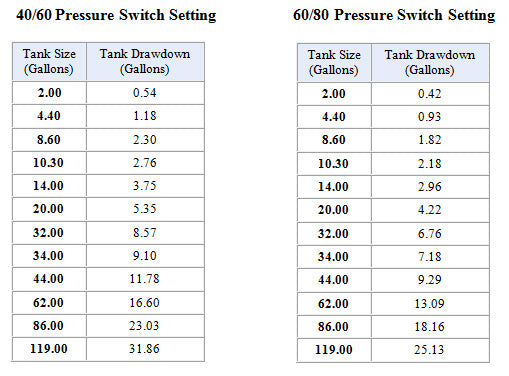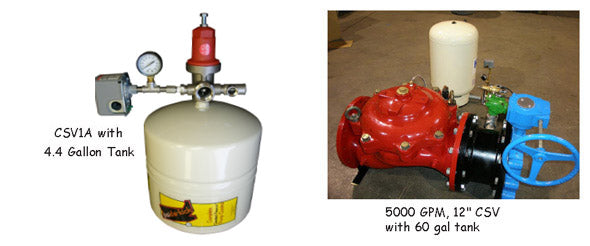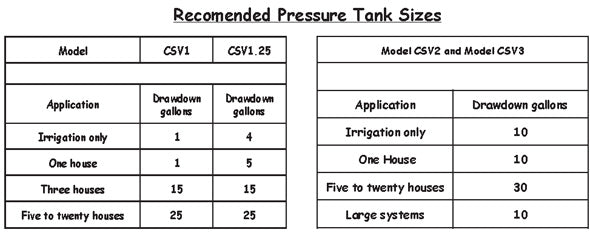Sizing a Pressure Tank with a CSV
Old Pressure Tank Sizing Method
In the past, pressure tanks were sized to store at least 1 or 2 gallons of water for every gallon per minute the pump can produce. A 10 GPM pump needed a pressure tank that holds 10 or 20 gallons. A 20 GPM pump needs a tank with 20 to 40 gallons of storage.
Almost 2/3s or more of a tanks volume is filled with compressed air, it takes a very large tank to hold 10 to 40 gallons of water. The higher the pressure switch setting, the less water volume a tank can store.
The following charts show the drawdown of tanks from 2 to 119 gallon actual size, with 40/60 compared to 60/80 pressure switch settings.


A pressure tank supplies water as the pressure drops from 60 to 40 PSI. At 40 PSI the pressure switch starts the pump, the pump fills the pressure tank to 60 PSI, and the pressure switch shuts off the pump. This is called a cycle. Cycling the pump on and off causes almost every problem with pump systems.
The maximum number of cycles allowed for a 1 HP pump to survive is 100 times per day. The average person in the US uses 75 gallons per day. Just one or two people in the house can use enough water to cycle the pump many times per day. Add a sprinkler, an open loop heat pump, or just a few kids, and that can easily cause more than 100 cycles per day. Larger pressure tanks reduce the number of cycles, but they don't stop cycling.
Cycling causes the premature destruction of pumps, motors, pressure switches, relays, capacitors, check valves, and even the pressure tank. Cycling causes water hammer which pounds on faucets, seals, washers, appliances, pipe, and pipe-fittings. Cycling the pump can cause the house lights to flicker and annoying swings in shower pressure. Cycling can cause pump wire chaffing, pumps coming unscrewed, noise, and high electric bills. Even problems with minimum flow for tankless water heaters can be attributed to cycling.
A Cycle Stop Valve (CSV), as the name implies, stops pumps from cycling. When water is being used, the pressure tank drains and the pressure switch starts the pump. The CSV then varies the flow from the pump to match the amount being used. Water flows past the pressure tank, directly to the faucet, at a constant 50 PSI. Only when all the faucets have been turned off, will the CSV allow 1 GPM to slowly fill the pressure tank to 60 PSI, and the pressure switch shuts off the pump.
Although a CSV will work with any size pressure tank, larger pressure tanks are no longer needed. With a CSV, a 4.4 gallon size tank, which holds 1 gallon of water, is sufficient for any size house. Larger pressure tanks are simply a waste of money and space.
Most size pressure tanks can be used with the CSV. Use our pressure tank sizing calculator to check your system.

